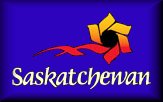| Moose
Jaw, with a population of approximately 33,000, is an urban centre with
historic charm in the heart of hard wheat country. The gateway to
Saskatchewan’s south central prairie region, the “Friendly City” boasts
a colourful past, a wealth of heritage and culture and a name that is remembered
across the continent.
Several theories exist on the origin of that name,
including the shape of a bend in the river and repair work done on a Red
River cart with a moose’s jawbone. The most popular and believable
theory notes the warm, prevailing winds that bless the city and concludes
that Moose Jaw is derived from “moosegaw”, a Cree word meaning warm breezes.
Moose Javians view their history with a mixture
of pride, amusement and ambivalence. The Roaring Twenties brought a measure
of notoriety to the city, with “celebrities” like Al Capone rumoured to
have stayed in downtown hotels. Getaway tunnels are said to exist
beneath many of the downtown buildings. The Tunnels of Little Chicago
tour shows you how the network of underground passages was used to smuggle
liquor during the prohibition era. While the tunnels are generally
associated with those heady days, they were actually built decades earlier
and were used by Chinese railroad workers avoiding the “head tax” of the
time.
With Canada’s Air Force 15 Wing stationed south
of Moose Jaw, Moose Jaw is the busiest airport in Canada in takeoffs and
landings. I5 Wing is the headquarters of the world renowned 431 Squadron
Snowbirds aerobatics team.
Moose Jaw as a city has a number of “must see”
attractions and is close to other interesting Saskatchewan “visitor sites”.
Within the city boundaries are the Western Development Museum which tells
the story of the history of transportation in Saskatchewan, Crescent Park
with the Moose Jaw Art Museum, the Tunnels of Little Chicago, the Murals
of Moose Jaw and the Moose Jaw Exhibition Burrowing Owls Interpretive Centre.
Nearby, but a car ride away, are the Sukanen Ship Pioneer Village
and Buffalo Pound Lake Park with the Nicolle Flats Interpretive Area and
Marsh Boardwalk.
The Wakamow Valley links six parks along the Moose
Jaw River and features walking and cycling trails, boardwalks, picnic areas
and playgrounds. Wakamow means “a turn” in Cree and refers to a sharp
bend in the river at Kingsway Park. Other recreational and
spa facilities include the Kinsmen Sportsplex, three 18- hole golf courses,
the Temple Gardens Mineral Spa and Resort Hotel and the Oasis Park waterslide.
Moose Jaw has an impressive collection of heritage
buildings in its downtown core and is working hard to restore and interpret
them. A number of historical walking tours are available. Prominent
artists have also painted historical murals on the sides of downtown buildings
– 26 in total – covering such topics as homesteading, the coming of the
railroad and an old-fashioned baseball game.
When you arrive in Moose Jaw by car you can stop
by the information centre on the Trans-Canada Highway north of the city.
While at the information centre you can pose next to one of the city’s
most visible landmarks, the giant “Mac the Moose” statue.
 As
part of the reunion materials you will be receiving a package of detailed
information about what you can see and do in Moose Jaw. You can also
click on the Saskatchewan emblem to get more travel information on the
Province. Our reunion schedule – for those who are interested - will
include the opportunity to “workout” in Wakamow Valley and to enjoy morning
and afternoon tours of Moose Jaw attractions. Moose Jaw in addition
to its attractions and recreational facilities has a variety of good restaurants
and interesting shops. Are you getting the feeling that three days
may not be enough? Plan now, book early and we’ll see you in July. As
part of the reunion materials you will be receiving a package of detailed
information about what you can see and do in Moose Jaw. You can also
click on the Saskatchewan emblem to get more travel information on the
Province. Our reunion schedule – for those who are interested - will
include the opportunity to “workout” in Wakamow Valley and to enjoy morning
and afternoon tours of Moose Jaw attractions. Moose Jaw in addition
to its attractions and recreational facilities has a variety of good restaurants
and interesting shops. Are you getting the feeling that three days
may not be enough? Plan now, book early and we’ll see you in July. |

